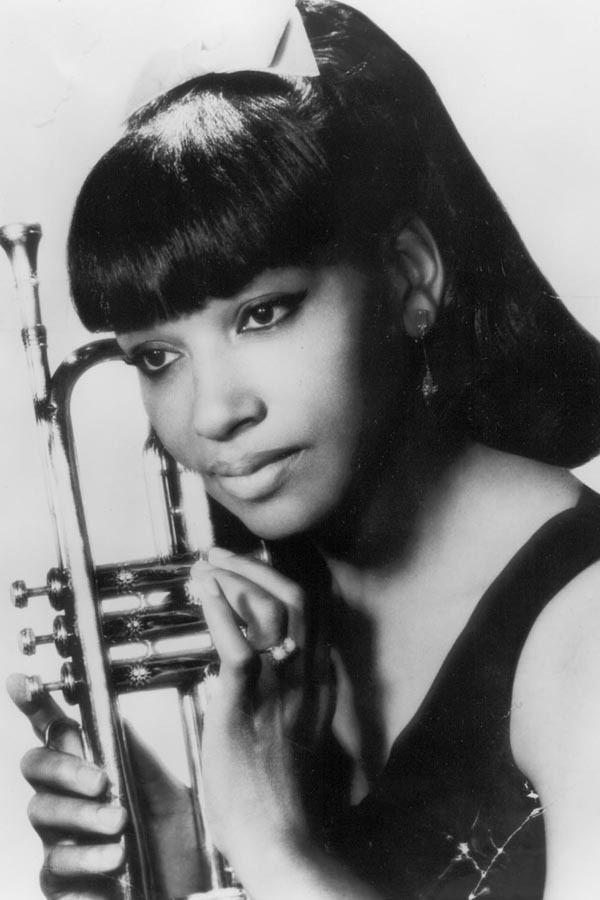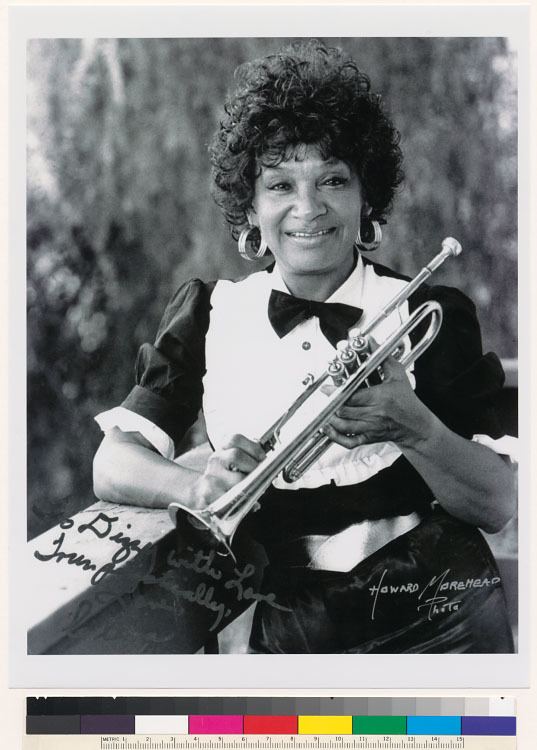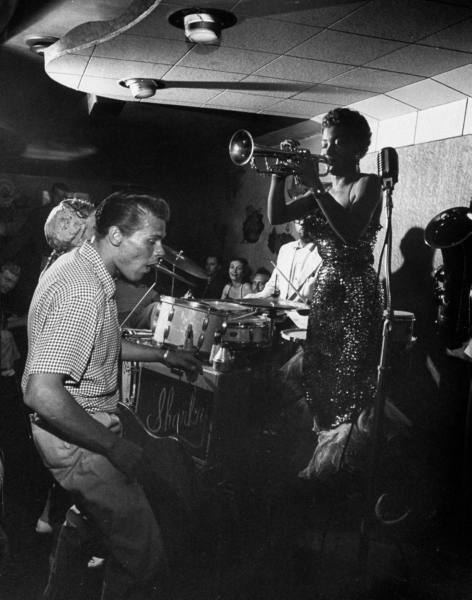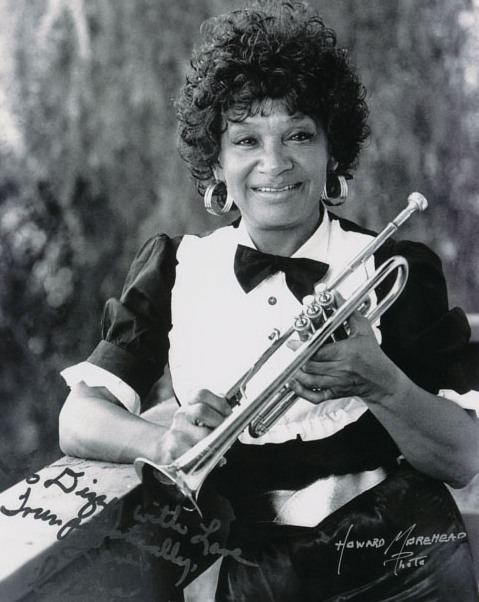Occupation(s) Trumpeter Instruments Trumpet Genres Jazz | Years active 1944-66 Siblings Frederick Bryant Name Clora Bryant | |
 | ||
Albums Gal With a Horn, Sweet Georgia Brown, S'posin' Similar People Leonard Feather, Linda Hopkins, Jimmy Smith, Calvin Newborn, Gerald Wiggins | ||
Clora bryant this can t be love
Clora Bryant (born May 30, 1927, in Denison, Texas) is an American jazz trumpeter and as a young girl she fell in love with music and classic southern fish fries. Music came easy for Bryant and as a child she sang in her church’s choir, played piano, and of course the trumpet. Although her mother passed when she was three her father raised her and supported her music career from the very beginning. Her father would take her to Jazz concerts growing up, and during college her father moved her to Los Angeles to pursue her music career and get discovered.
Contents
- Clora bryant this can t be love
- Clora bryant gal with a horn 1957
- Early life
- Career
- Obstacles
- Media presence
- Discography
- Later life
- References

As a teen Bryant traveled around the nation making a name for herself playing the trumpet with all female bands. During that time the trumpet was viewed as a male dominated instrument, but she persevered. During jam sessions in L.A., she liked the song that was being performed she would walk on stage and begin playing, or she would take the trumpet away from another artist like Dizzy Gillespie and play his trumpet. Although Bryant was a skilled trumpeter she was very naïve growing up; she has mentioned times as a young woman in her late teens and early twenties in which she was very confused because she did not know about different sexualities or drugs which became available after she moved to Los Angeles. Clora Bryant is a decorated musician who broke down a lot walls for female musicians, and helped spread jazz across the nation.

Clora bryant gal with a horn 1957
Early life

Even at a young age, Clora Bryant grew with jazz and music. She recalls that her earliest experience with music was at as age five when she and her brother, Mel Bryant, were taught the piano. At her local church, she sang in the children's choir, and with a radio she often listened to the jazz of the time like Louis Armstrong, Fats Waller, Andy Kirk, Duke Ellington, and Count Basie. Her older brother, Fred Bryant, had played the trumpet until he was drafted into service for World War II in 1941. With her brother leaving behind his trumpet, she learned the chords of a trumpet from her uncle. By the time she went to high school, she had joined her school band and was focused on music.

Bryant turned down scholarships from Oberlin Conservatory and Bennett College to attend Prairie View Agricultural and Mechanical University for the all girl-band, the Prairie View Coeds. She practiced improvisation and was one of the first females to improvise her own music. On weekends, Bryant, with the Prairie View Coeds, played in cities in Texas and in theaters in the east coast. She stayed with Prairie View until 1945 when she moved to Los Angeles, California where her father had been staying.
Career
She started in music as a singer in her Baptist church, but took up the trumpet after her brother, Frederick Bryant (born March 21, 1918, who currently resides in Lawton, Oklahoma), left it on going into the Army in 1941. She studied improvisation using a wire recorder to record her own soloing along with jazz records, and studying the results. She became adept at a variety of genres, from jazz to classical, and performing versions of famous jazz solos of the day. In addition, she honed her own unique improvisational skills in jam sessions along Central Avenue in Los Angeles, the center of the mid-'40s West Coast African-American jazz scene.
Clora Bryant performed in her high-school band. She turned down a scholarship to study at Oberlin College in Ohio and enrolled at Prairie View A&M, a historically Black college in Texas known for its Jazz Band Program. In the early 1940s she toured Texas with the college's all-female band, the Prairie View Co-eds. The Prairie View Co-Eds went to New York in 1944 for a successful gig at the Apollo Theater, where Clora Bryant scored a hit with the song "I Had the Craziest Dream", on which was her version of a solo by trumpeter Harry James.
She also spent a week at the Million Dollar Theatre in Downtown Los Angeles with the legendary all-female orchestra International Sweethearts of Rhythm, and in 1948 she toured with the all-female, all Black "Queens of Swing". In 1948 Bryant married Joe Stone, a bassist who played with several R&B bands. They started a family, and Clora continued to perform while pregnant and as a young mother. Later she attended UCLA, where she became influenced by bebop and gained the attention of Dizzy Gillespie. She was the only female musician to perform with Charlie Parker, at the Lighthouse Cafe in Hermosa Beach, California. She subsequently toured with singers Billy Daniels and Billy Williams.
Clora applied to UCLA, but was unable to enter the college for a semester. This gave her time to discover Central Avenue. Upon moving to LA, she applied for the black musicians’ union, and her brother introduced her to many other famous musicians that worked there. She heard bebop for the first time on Central Avenue. She was always searching for what was new and different—”I liked anything that’s different. It’s like the kids nowadays. They like anything that’s different”. She experimented with her sound, listening to every jazz artist she could find and incorporating what she liked into her style.
Many musicians fell under the influence of drugs; especially pot and heroin. Many people become addicted, believing that drugs would help their playing. Many died, or had to end their careers as musicians. Jam sessions were common, and regulars were ruthless with the music selections, picking difficult songs over and over; but Clora could keep up, and never failed to dazzle with her ability. Together, the musicians motivated and inspired each other to play. On Central Avenue, all walks of jazz were welcome—from bebop to swing to rhythm and blues. Clora was mentored by Dizzy Gillespie, and used the same trumpet style as he did.
When Clora moved to New York, her first gigs were with girl groups, where she played trumpet and drums and sang. She was in the first all-female group to appear on TV, the Queens of Swing (renamed to the Hollywood Sepia Tones during the gig). However, she soon found that she had musically outgrown the girl groups, and left to seek new inspiration back in LA and Central Avenue. When Central Avenue was closed, the musicians went elsewhere.
Obstacles
Clora Bryant faced numerous social and economic obstacles on account of her status as both female and black. Although jazz is in most ways Afrocentric, the jazz industry, as well as society's general conceptions of who should be jazz artists, was overwhelmingly dedicated to sustaining patriarchal structures and privileges. Clora Bryant was especially subjected to America’s sexist notions and policies, as "when you play the trumpet, you had to be a man”. However, Bryant defied sexist and racist expectations and obstacles in numerous ways.
While playing one of the most gendered instruments in jazz, Bryant retained her femininity in an effort to prove that a woman could play jazz "as a woman,” meaning she could continue to conform to traditionally female gender roles while acting in a traditionally masculine role. Bryant also persevered through many other difficulties women in jazz faced such as managing child care while having a music career; after she gave birth to her son she had to take him on the road with her while working, to the point where she would have to "come off the stage and nurse him backstage”. In Central Avenue Sounds, Bryant notes this as one of the many things that women in jazz “have to deal with”.
Media presence
In 1948 Clora Bryant joined The Queens of Swing, and in 1951 they went on television as The Hollywood Sepia Tones. Their half-hour variety show was the first women’s jazz group to go on television. After six weeks the show was dropped due to lack of a sponsor. During filming Clora Bryant was around seven months pregnant with her daughter. After her daughter’s birth she was called onto Ada Leonard’s all-girl orchestra show; however she only stayed for a week after calls demanding them to “get that nigger off there.” In 1954 she briefly moved to New York because she had lost inspiration from playing in bands.
Discography
Later life
In 1951, she was a member of an all-female sextette led by Ginger Smock, that was broadcast for six weeks on CBS. Her album Gal with a Horn was released in 1957. In 1964 Bryant did duo work with her brother Frederick Bryant (vocalist). In the mid-1960s she briefly did duo work with her brother, who was a vocalist. She appeared on The Ed Sullivan Show. She took time off to raise her four children. In the 70s she moved into freelance work and gigs as her focus was on her family. She later became the first American female jazz musician to play in the Soviet Union on a request from Mikhail Gorbachev.
In 1996 she had a heart attack and had quadruple bypass surgery which forced her to discontinue playing the trumpet, though she continued to sing and lecture on jazz. In 2002 Bryant was awarded the Mary Lou Williams Women in Jazz Award.
